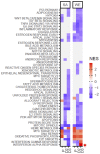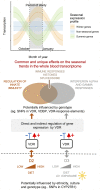Vitamins D2 and D3 Have Overlapping But Different Effects on the Human Immune System Revealed Through Analysis of the Blood Transcriptome
- PMID: 35281034
- PMCID: PMC8908317
- DOI: 10.3389/fimmu.2022.790444
Vitamins D2 and D3 Have Overlapping But Different Effects on the Human Immune System Revealed Through Analysis of the Blood Transcriptome
Abstract
Vitamin D is best known for its role in maintaining bone health and calcium homeostasis. However, it also exerts a broad range of extra-skeletal effects on cellular physiology and on the immune system. Vitamins D2 and D3 share a high degree of structural similarity. Functional equivalence in their vitamin D-dependent effects on human physiology is usually assumed but has in fact not been well defined experimentally. In this study we seek to redress the gap in knowledge by undertaking an in-depth examination of changes in the human blood transcriptome following supplementation with physiological doses of vitamin D2 and D3. Our work extends a previously published randomized placebo-controlled trial that recruited healthy white European and South Asian women who were given 15 µg of vitamin D2 or D3 daily over 12 weeks in wintertime in the UK (Nov-Mar) by additionally determining changes in the blood transcriptome over the intervention period using microarrays. An integrated comparison of the results defines both the effect of vitamin D3 or D2 on gene expression, and any influence of ethnic background. An important aspect of this analysis was the focus on the changes in expression from baseline to the 12-week endpoint of treatment within each individual, harnessing the longitudinal design of the study. Whilst overlap in the repertoire of differentially expressed genes was present in the D2 or D3-dependent effects identified, most changes were specific to either one vitamin or the other. The data also pointed to the possibility of ethnic differences in the responses. Notably, following vitamin D3 supplementation, the majority of changes in gene expression reflected a down-regulation in the activity of genes, many encoding pathways of the innate and adaptive immune systems, potentially shifting the immune system to a more tolerogenic status. Surprisingly, gene expression associated with type I and type II interferon activity, critical to the innate response to bacterial and viral infections, differed following supplementation with either vitamin D2 or vitamin D3, with only vitamin D3 having a stimulatory effect. This study suggests that further investigation of the respective physiological roles of vitamin D2 and vitamin D3 is warranted.
Keywords: adaptive immunity; ethnicity; human transcriptome; immunomodulation; innate immunity; vitamin D supplementation; vitamin D2; vitamin D3.
Copyright © 2022 Durrant, Bucca, Hesketh, Möller-Levet, Tripkovic, Wu, Hart, Mathers, Elliott, Lanham-New and Smith.
Conflict of interest statement
The authors declare that the research was conducted in the absence of any commercial or financial relationships that could be construed as a potential conflict of interest.
Figures







Similar articles
-
Daily supplementation with 15 μg vitamin D2 compared with vitamin D3 to increase wintertime 25-hydroxyvitamin D status in healthy South Asian and white European women: a 12-wk randomized, placebo-controlled food-fortification trial.Am J Clin Nutr. 2017 Aug;106(2):481-490. doi: 10.3945/ajcn.116.138693. Epub 2017 Jul 5. Am J Clin Nutr. 2017. PMID: 28679555 Clinical Trial.
-
Effects of vitamin D2 or D3 supplementation on glycaemic control and cardiometabolic risk among people at risk of type 2 diabetes: results of a randomized double-blind placebo-controlled trial.Diabetes Obes Metab. 2016 Apr;18(4):392-400. doi: 10.1111/dom.12625. Epub 2016 Feb 4. Diabetes Obes Metab. 2016. PMID: 26700109 Free PMC article. Clinical Trial.
-
Effect of supplementation of vitamin D3 or vitamin D2 on serum concentrations of free and total 25-hydroxyvitamin D and the expression of genes involved in immune function in peripheral blood mononuclear cells of weaned pigs.Arch Anim Nutr. 2023 Jun;77(3):228-244. doi: 10.1080/1745039X.2023.2219176. Epub 2023 Jun 19. Arch Anim Nutr. 2023. PMID: 37335004
-
Folic acid supplementation and malaria susceptibility and severity among people taking antifolate antimalarial drugs in endemic areas.Cochrane Database Syst Rev. 2022 Feb 1;2(2022):CD014217. doi: 10.1002/14651858.CD014217. Cochrane Database Syst Rev. 2022. PMID: 36321557 Free PMC article.
-
Noncalcemic adverse effects and withdrawals in randomized controlled trials of long-term vitamin D2 or D3 supplementation: a systematic review and meta-analysis.Nutr Rev. 2017 Dec 1;75(12):1007-1034. doi: 10.1093/nutrit/nux059. Nutr Rev. 2017. PMID: 29202186
Cited by
-
COVID-19 and neurological sequelae: Vitamin D as a possible neuroprotective and/or neuroreparative agent.Life Sci. 2022 May 15;297:120464. doi: 10.1016/j.lfs.2022.120464. Epub 2022 Mar 7. Life Sci. 2022. PMID: 35271880 Free PMC article. Review.
-
Association of vitamin D with depression prevalence in U.S. adults: a cross-sectional analysis from NHANES 2021 to 2023.Front Nutr. 2025 May 27;12:1545443. doi: 10.3389/fnut.2025.1545443. eCollection 2025. Front Nutr. 2025. PMID: 40497025 Free PMC article.
-
Vitamin A, D, E, and K as Matrix Metalloproteinase-2/9 Regulators That Affect Expression and Enzymatic Activity.Int J Mol Sci. 2023 Dec 1;24(23):17038. doi: 10.3390/ijms242317038. Int J Mol Sci. 2023. PMID: 38069361 Free PMC article. Review.
-
Scientific opinion on the tolerable upper intake level for vitamin D, including the derivation of a conversion factor for calcidiol monohydrate.EFSA J. 2023 Aug 8;21(8):e08145. doi: 10.2903/j.efsa.2023.8145. eCollection 2023 Aug. EFSA J. 2023. PMID: 37560437 Free PMC article.
-
Differential Enhancement of Fat-Soluble Vitamin Absorption and Bioefficacy via Micellization in Combination with Selected Plant Extracts In Vitro.Nutrients. 2025 Jan 20;17(2):359. doi: 10.3390/nu17020359. Nutrients. 2025. PMID: 39861489 Free PMC article.
References
Publication types
MeSH terms
Substances
Grants and funding
LinkOut - more resources
Full Text Sources
Miscellaneous

